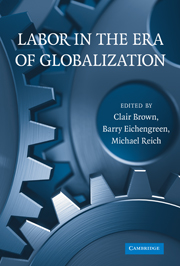Book contents
- Frontmatter
- Contents
- Tables and Figures
- List of Authors and Editors
- Introduction: Labor in the Era of Globalization
- PART ONE POLITICAL ECONOMY AND LABOR MARKET INSTITUTIONS
- PART TWO INSTITUTIONS AND FIRM AND WORKER BEHAVIOR
- PART THREE CONTEMPORARY LABOR–MANAGEMENT RELATIONS
- PART FOUR PUBLIC POLICY AND U.S. LABOR-MARKET STRUCTURE
- 11 Minimum Wages in the United States: Politics, Economics, and Econometrics
- 12 The Causes and Labor-Market Consequences of the Steep Increase in U.S. Incarceration Rates
- 13 Local Labor-Market Adaptation to Increased Immigration
- Index
- References
11 - Minimum Wages in the United States: Politics, Economics, and Econometrics
Published online by Cambridge University Press: 05 June 2012
- Frontmatter
- Contents
- Tables and Figures
- List of Authors and Editors
- Introduction: Labor in the Era of Globalization
- PART ONE POLITICAL ECONOMY AND LABOR MARKET INSTITUTIONS
- PART TWO INSTITUTIONS AND FIRM AND WORKER BEHAVIOR
- PART THREE CONTEMPORARY LABOR–MANAGEMENT RELATIONS
- PART FOUR PUBLIC POLICY AND U.S. LABOR-MARKET STRUCTURE
- 11 Minimum Wages in the United States: Politics, Economics, and Econometrics
- 12 The Causes and Labor-Market Consequences of the Steep Increase in U.S. Incarceration Rates
- 13 Local Labor-Market Adaptation to Increased Immigration
- Index
- References
Summary
INTRODUCTION
In the past twenty-five years, real wages declined for less-educated workers and stagnated for most middle- and upper-income groups. In the same period, economy-wide productivity increased and incomes rose dramatically at the very top of the income distribution. Some observers attribute these developments primarily to globalization and technological change. Others place more emphasis on changes in labor-market institutions – specifically, on three institutional changes: the decline in unions' economic and political power, shifting social norms regarding CEO compensation, and falling minimum-wage standards (Levy and Temin, Chapter 1, this volume).
Of these three changes, unions are still weak and CEO compensation remains high. However, popular political organizations and coalitions have emerged and worked successfully to restore minimum-wage standards. Despite the conservative tenor of this era, these campaigns have been increasingly successful.
In this chapter, I review first the recent political evolution of campaigns to increase local and state wage standards. Such campaigns have succeeded in a variety of environments, including states with high housing costs, more liberal political traditions, and both declining and expanding economic fortunes. State minimum-wage differentials have become a durable part of the labor market. To increase their scale, minimum-wage advocates increasingly have undertaken ballot campaigns, with fairness and meeting basic needs as their main arguments. Then, I analyze the impacts of federal and state minimum-wage increases on employment – first descriptively, and then statistically.
- Type
- Chapter
- Information
- Labor in the Era of Globalization , pp. 353 - 374Publisher: Cambridge University PressPrint publication year: 2009
References
- 5
- Cited by



